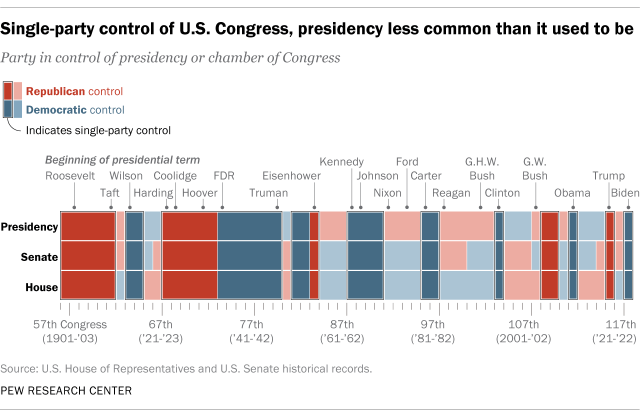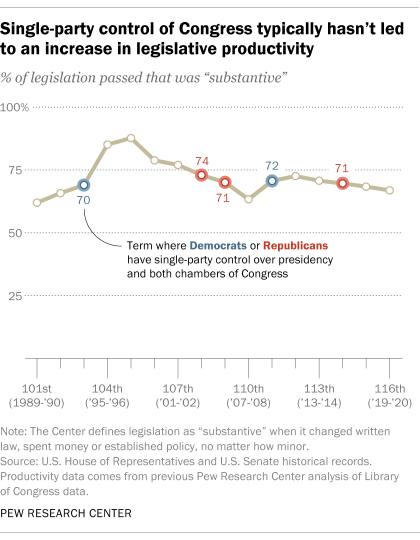January’s Democratic victories in a pair of tight Senate runoff elections in Georgia ensured that Joe Biden would begin his presidency with his party as the majority of both chambers of Congress.
In an era marked by deep and intense partisan divisions, single-party control of the executive and legislative branches might seem rare. But unified government at the beginning of a president’s first term has actually been the norm, especially for Democratic presidents, according to a Pew Research Center analysis of data going back to the 56th Congress (1899-1901). In fact, it’s been the case for 16 of 21 presidents dating to Theodore Roosevelt. The five exceptions were all Republicans: George W. and George H.W. Bush, Ronald Reagan, Gerald Ford and Richard Nixon.
With Democrats in charge of the White House and both chambers of Congress, we conducted this analysis to determine how often one party has held the presidency, House of Representatives and Senate at the same time, as well as how long such periods of single-party control usually last.
The analysis uses archival records from the historical offices of the House of Representatives and the Senate. We began our analysis in the 56th Congress (1899-1901) because independent parties made up larger portions of the U.S. Congress prior to that session. Data on legislative leadership is based on the beginning of each Congress; it does not take into account any changes that may have occurred later in the same Congress. In the 107th Congress of 2001-2002, for example, the Senate is counted under Democratic control because that was the balance at the start of the session, even though leadership flipped between the parties three times that Congress. For the 117th Congress, we used Jan. 21, 2021, as the starting point for that Congress because several new members were sworn in to fill vacancies.
Information about congressional productivity comes from a separate Pew Research Center analysis examining the productivity of Congress over time. That analysis uses data from the Library of Congress to calculate how many substantive laws were passed in a session. Substantive legislation, according to our definition, changed written law, spent money or established policy, no matter how minor.
The current Senate is notable because it is evenly split between Democrats and Republicans, giving Democrats narrow control of the chamber (with Vice President Kamala Harris’ vote breaking any ties).
Although a single party in charge in Washington is common at the beginning of a new president’s term, there has only been one presidency since 1969 where control has lasted beyond the following midterm election. That was during Democratic President Jimmy Carter’s one term in office, when Democrats retained leadership of the House and Senate in both the 95th and the 96th Congress (1977-1978 and 1979-1980). Republican George W. Bush also enjoyed single-party control for several years (during the 108th and 109th Congress, spanning 2003-2006), but not at the beginning of his tenure.
Republican Donald Trump (2017) and Democrats Barack Obama (2009) and Bill Clinton (1993) all entered office with the House and Senate led by their respective party. In each of these presidencies, at least one chamber flipped in the following election. For example, during the 1994 midterms following Clinton’s election, both houses switched from a Democratic to Republican majority.
Between the turn of the century and the 1970s, one-party control of the legislative and executive branches often lasted several consecutive congressional sessions. The longest such stretch lasted nearly 26 years. Republicans led all three from March 1921 to March 1933, when Democrats took over and maintained power until January 1947.
Since then, the longest period of leadership for any one party has been eight years, when Democrats maintained one-party control from the beginning of President John F. Kennedy’s term (87th Congress of 1961-1962) to the end of Lyndon B. Johnson’s (90th Congress of 1967-1968). In the 27 congressional sessions following Johnson’s presidency, one-party control has existed for just eight total sessions.
During at least the last 16 congressional sessions, starting with the 101st Congress (1989-1990), single-party dominance in Washington hasn’t necessarily corresponded with high levels of legislative productivity, as measured by a Pew Research Center analysis of “substantive” legislation passed in each Congress. (Our analysis defines substantive legislation as legislation that changed written law, spent money or established policy, no matter how minor.)
In that more than three-decade span, four of the five most productive sessions occurred during periods of divided government. The three sessions with the highest legislative productivity rates – when between 80% and 89% of the bills passed were substantive – all occurred during divided government under the Clinton administration. During the 108th Congress (2003-2004), the most productive session under unified control, about three-quarters (74%) of legislation passed was substantive.


